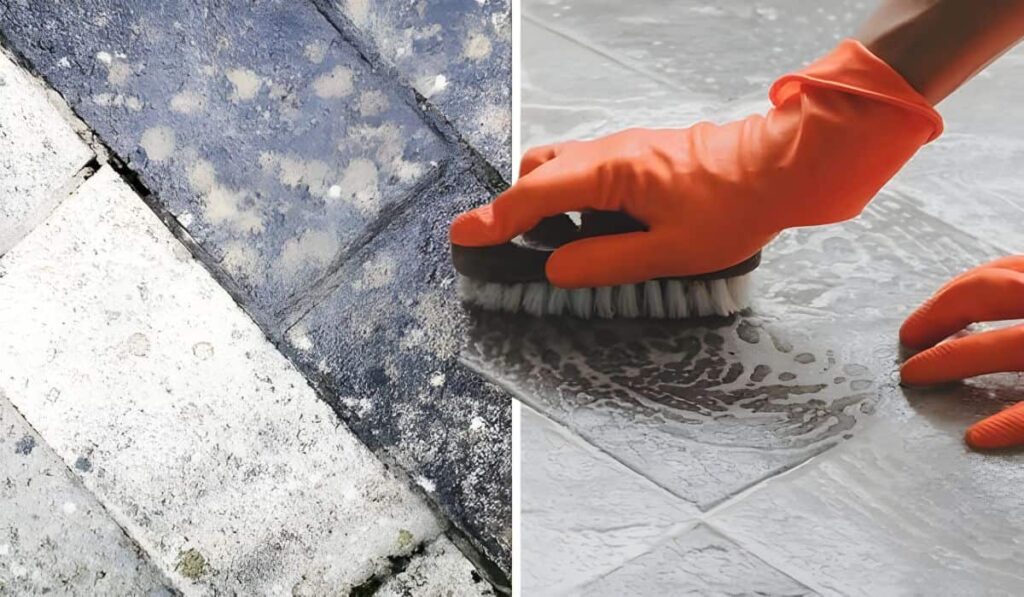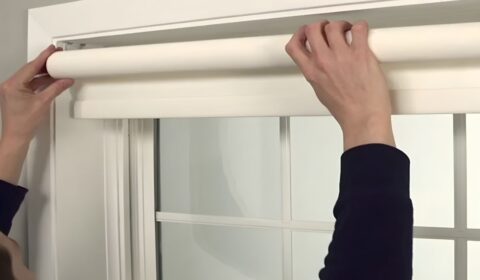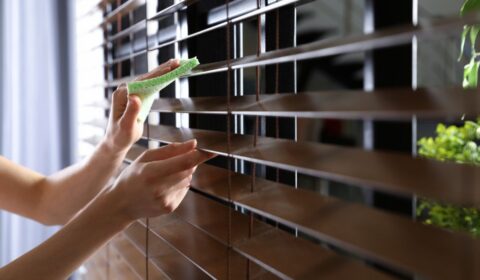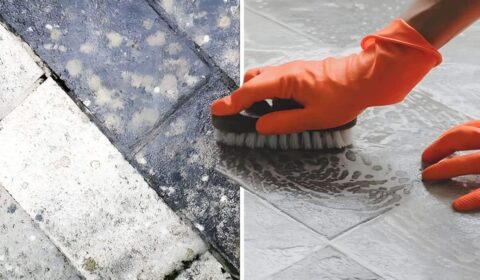To clean patio slabs:
Sweep away debris, then scrub with warm soapy water or a vinegar solution for natural cleaning. For tough dirt or green algae, apply diluted bleach or clean using a pressure washer. Always rinse thoroughly and let the slabs dry completely.
Patio slabs are a fantastic addition to any garden, providing a practical and stylish area for dining, relaxing, and entertaining. However, over time, they can accumulate dirt, algae, moss, and stains, making them look tired and neglected. Keeping your patio clean not only improves its Appearance but also helps prevent slips and damage caused by unwanted growths and debris.
In this comprehensive guide, we’ll walk you through the process of cleaning patio slabs using various methods, ranging from natural solutions to commercial cleaners. Whether you have porcelain, concrete, sandstone, or limestone slabs, we’ve got you covered with tips to keep your patio looking its best all year round.
Why Cleaning Patio Slabs is Important?
A well-maintained patio doesn’t just look great – it’s also safer and lasts longer. Here are a few key reasons to clean your patio regularly:
Enhances Appearance
Over time, patio slabs can become discoloured due to weather exposure, muddy shoes, plant debris, and marks from garden furniture. Cleaning restores their natural colour, making your outdoor space more inviting.
Prevents Slips and Falls
Moss, algae, and lichen can create a slippery surface, especially in wet weather. Regular cleaning reduces this risk, making your patio safer for everyone.
Prolongs the Life of the Slabs
Built-up dirt and moss can damage the surface of the slabs over time. Regular cleaning helps prevent damage, reducing the need for expensive repairs or replacements.
Discourages Weed Growth
Weeds growing between patio joints not only look unsightly but can also loosen slabs over time. A thorough clean helps keep weeds at bay.
Tools and Materials You’ll Need
Before you start, gather the following essentials for cleaning patio slabs effectively:
- Stiff-bristled broom or brush
- Bucket
- Garden hose or pressure washer (optional)
- Rubber gloves
- Protective eyewear (if using bleach or strong cleaners)
- Patio cleaner or natural cleaning ingredients
- Weed scraper or trowel
- Old clothes or towels for drying
How to Clean Patio Slabs Naturally?
If you prefer an eco-friendly approach, there are several natural methods for cleaning patio slabs. These are especially suitable if you have pets or young children who play outdoors.
Using Vinegar and Water
Vinegar is a fantastic natural cleaner that helps break down dirt and moss.
Steps:
- Mix equal parts white vinegar and water in a bucket.
- Pour the solution over the patio, ensuring it soaks into stained or green areas.
- Leave it for 20–30 minutes to work its magic.
- Scrub with a stiff-bristle brush to loosen dirt and moss.
- Rinse thoroughly with a garden hose.
Tip: Avoid using vinegar on natural stone like limestone or sandstone, as it can cause damage.
Using Baking Soda
Baking soda is another safe and effective option for cleaning dirty patio slabs.
Steps:
- Sprinkle baking soda directly onto the slabs, focusing on stained spots.
- Spray with water to form a paste-like consistency.
- Scrub the area with a brush.
- Rinse thoroughly with fresh water and allow it to air dry naturally.
Hot Soapy Water
For everyday dirt and grime, warm soapy water is usually sufficient.
Steps:
- Fill a bucket with hot water and add a few drops of washing-up liquid.
- Pour the mixture over the slabs.
- Scrub vigorously with a stiff brush.
- Rinse well with a garden hose.
This method is ideal for regular maintenance cleaning.
How to Clean Patio Slabs with Bleach?
Bleach is a powerful cleaning agent that works well for heavily soiled or green patio slabs. However, it must be used with care to avoid harming plants, pets, or nearby lawn areas.
Steps:
- Dilute one part bleach with five parts water in a bucket.
- Wear gloves and protective eyewear for safety.
- Pour the mixture over the patio, avoiding plants and grass.
- Leave it to sit for 10–15 minutes.
- Scrub thoroughly with a brush to lift dirt and algae.
- Rinse generously with water to remove all bleach residue.
Important: Never mix bleach with other cleaning products, such as vinegar or ammonia, as this can create toxic fumes.
How to Clean Green Patio Slabs?
Green patio slabs are typically caused by algae or moss growth. These not only look unattractive but also make the surface slippery.
Best Cleaning Method:
- Start by scraping off moss with a weed scraper or trowel.
- Use a vinegar and water mix or diluted bleach to tackle stubborn areas.
- Scrub thoroughly and rinse well.
- Allow the patio to dry completely to discourage regrowth.
How to Clean Porcelain Patio Slabs?
Porcelain slabs are renowned for their durability and low maintenance, but they still require occasional cleaning to maintain their pristine appearance.
Steps:
- Sweep thoroughly to clear away loose dirt and debris.
- Mix a bucket of warm, soapy water using mild washing-up liquid.
- Use a soft-bristled brush to clean the surface, avoiding abrasive scrubbing.
- Rinse thoroughly with clean water to prevent streaks.
- Dry with an old towel for a streak-free finish.
Tip: Avoid using bleach or acidic cleaners on porcelain slabs, as they can damage the smooth surface.
How to Clean Dirty Patio Slabs with a Pressure Washer?
A pressure washer can make cleaning quick and effective, especially for large patios. However, it must be used carefully to avoid damaging the slabs or grout.
Steps:
- Clear the area of furniture, plant pots, and loose debris.
- Start on a low-pressure setting to prevent damage.
- Hold the nozzle at a slight angle, about 12–18 inches away from the surface.
- Work in sections, moving in sweeping motions.
- Rinse thoroughly and let it air dry.
Note: Some delicate materials, like sandstone, may not be suitable for high-pressure cleaning.
Preventative Tips to Keep Patio Slabs Clean
Cleaning your patio doesn’t have to be a big job every time. By maintaining it regularly, you can keep it looking fresh with minimal effort.
- Sweep weekly to remove leaves and debris.
- Trim nearby plants to prevent the growth of moss and algae.
- Apply a patio sealant annually to protect the surface from damage.
- Deal with stains promptly before they set in.
- Keep furniture clean to avoid rust and dirt marks.
Common Patio Cleaning Mistakes to Avoid
To achieve the best results, steer clear of these common mistakes:
- Using bleach on delicate natural stones like sandstone or limestone.
- Applying too much pressure with a power washer can damage the slabs.
- Neglecting to rinse off cleaning solutions leaves behind residue.
- Ignoring weeds and moss can cause long-term damage.
- Mixing incompatible cleaning chemicals.
Final Thoughts
Cleaning your patio slabs doesn’t have to be a daunting task. Whether you prefer natural solutions or more potent cleaning agents, there’s a method to suit every type of slab and level of dirt. By following these steps and maintaining your patio regularly, you can enjoy a safe, attractive, and long-lasting outdoor space.
A clean patio not only boosts the Appearance of your garden but also makes it a more enjoyable place for gatherings, barbecues, and quiet moments of relaxation. With a bit of care and attention, your patio will stay in top condition for years to come.
Frequently Ask Questions
Can I use washing-up liquid to clean patio slabs?
Yes, mild washing-up liquid mixed with warm water works well for general cleaning and is safe for most patio materials.
What is the best way to clean green algae off patio slabs?
A vinegar and water solution or diluted bleach works well for removing algae. Just remember to rinse thoroughly afterwards.
Are pressure washers safe for all types of patio slabs?
Not always. While concrete and porcelain slabs can usually handle pressure washing, softer stones like sandstone may chip or erode.
How do I prevent moss from growing back?
Regular sweeping, keeping the patio dry, and applying a sealant or moss inhibitor can help prevent regrowth.





